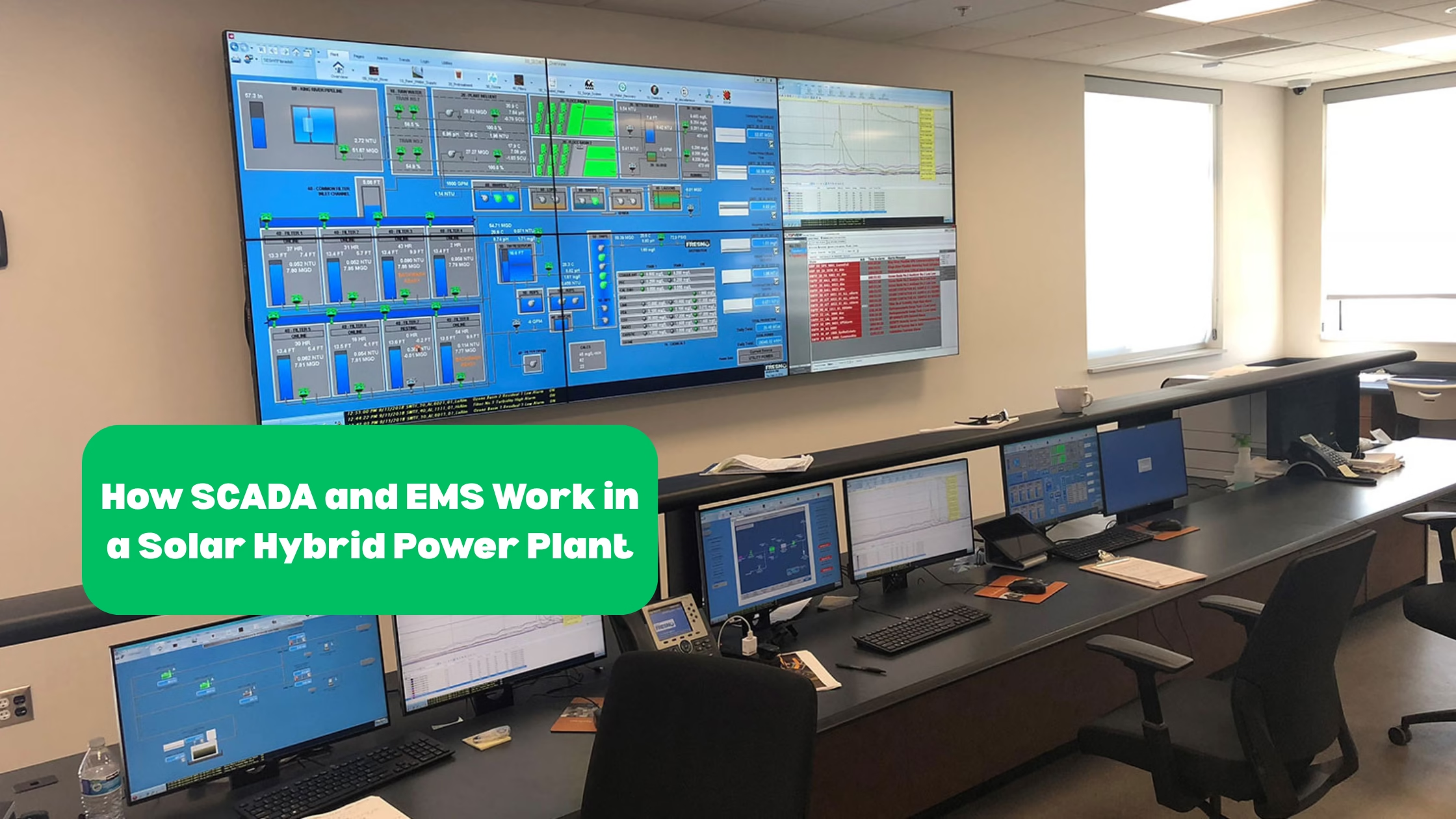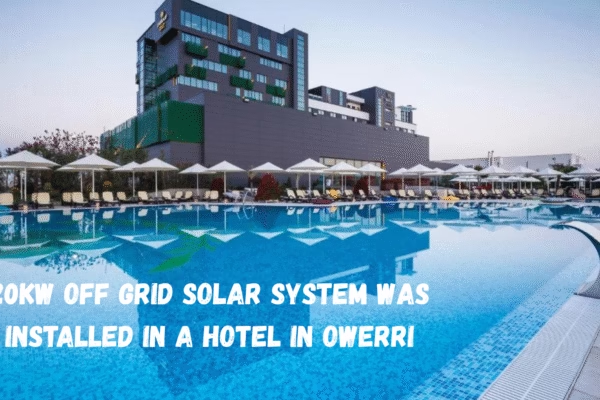As solar hybrid power plants grow in importance, delivering clean, reliable, and efficient energy, two digital systems ensure these plants perform at their best: SCADA (Supervisory Control and Data Acquisition) and EMS (Energy Management System). Together, they form the intelligence backbone of modern hybrid renewable power systems.
In this comprehensive guide, we’ll explore what SCADA and EMS are, how they work, their differences, and why they are essential for the success of large-scale solar hybrid projects.
Understanding Solar Hybrid Power Plants
A solar hybrid power plant is a power generation system that combines solar photovoltaic (PV) energy with other sources like battery energy storage systems (BESS), diesel generators (DGs), and sometimes even the grid. The goal is to ensure stable, reliable, and cost-effective electricity production even when sunlight is intermittent.
Key components include:
- PV Modules & Inverters – capture sunlight and convert DC to usable AC electricity.
- BESS (Battery Energy Storage System) – stores excess solar energy and discharges it when needed.
- DGs (Diesel Generators) – provide backup power during low solar and battery availability.
- Transformers & MV Bus – step-up or step-down voltage and distribute power across the plant.
- Control Systems (SCADA & EMS) – the digital layer that manages, monitors, and optimizes plant operations.
Without SCADA and EMS, coordinating all these moving parts efficiently would be nearly impossible.
What is SCADA in a Solar Hybrid Plant?
SCADA is the monitoring and control system of a solar hybrid power plant. It functions like the central dashboard that provides operators with real-time insights into how the plant is performing.
Key Functions of SCADA:
- Monitoring:
- Tracks voltage, current, and power output from PV strings, inverters, transformers, BESS, and DGs.
- Gathers environmental data such as solar irradiance, temperature, and wind speed from weather stations.
- Control:
- Enables operators to start/stop inverters, open or close breakers, and remotely control DGs or PCS.
- Alarming:
- Raises alerts when equipment malfunctions, trips, or operates outside of safe limits.
- Data Logging:
- Stores historical data on generation, consumption, and battery usage for analysis.
- Visualization:
- Provides single-line diagrams (SLDs), dashboards, and reports for operators and stakeholders.
👉 Example: If an inverter trips due to overvoltage, SCADA logs the event, raises an alarm, and enables the operator to reset it remotely.
What is EMS in a Solar Hybrid Plant?
While SCADA handles monitoring and basic control, the Energy Management System (EMS) provides advanced intelligence. It is the decision-making and optimization layer above SCADA. If SCADA is the plant’s eyes and hands, EMS is the brain.
Key Functions of EMS:
- Dispatch Optimization:
- Decides how much energy should come from PV, how much should be stored in or released from batteries, and when to run DGs.
- Battery Management:
- Ensures efficient battery charging during peak solar hours and discharging during evening demand peaks.
- Grid Compliance:
- Regulates voltage, frequency, and reactive power support to meet utility standards.
- Cost Optimization:
- Minimizes fuel costs by reducing DG usage.
- Maximizes renewable energy penetration.
- Forecasting:
- Uses weather forecasts and load predictions to plan energy flows in advance.
👉 Example: On a sunny afternoon, EMS may choose to charge the battery while supplying the load directly from solar. Later in the evening, it can discharge the battery to meet demand, avoiding unnecessary DG operation.
How SCADA and EMS Work Together
| Feature | SCADA | EMS |
| Role | Monitor & Control | Optimize & Manage |
| Focus | Equipment-level | System-level |
| Data | Real-time measurements | Forecast + Real-time + Historical |
| Decisions | Operator/manual | Automatic algorithms |
| Example | Reset inverter | Decide PV/BESS/DG dispatch mix |
In short:
- SCADA provides the data and the ability to act.
- EMS makes the strategic decisions to optimize the plant.
Simplified Block Diagram
+——————-+
| EMS | <— Brain (decides best energy dispatch)
+——————-+
|
+——————-+
| SCADA | <— Eyes & Hands (monitor + control)
+——————-+
/ | \
[PV & Inverters] [BESS + PCS] [DG + Grid]
- SCADA: Collects all field data and executes control commands.
- EMS: Uses SCADA’s data plus forecasts to decide how best to operate.
Benefits of SCADA and EMS in Solar Hybrid Power Plants
- Reliability:
- Ensures uninterrupted power supply by seamlessly switching between PV, BESS, DG, and Grid.
- Efficiency:
- Optimizes energy flows to maximize solar utilization and minimize diesel usage.
- Cost Savings:
- Reduces operating costs by lowering fuel consumption and preventing equipment damage.
- Grid Support:
- Provides voltage and frequency stabilization to strengthen weak or remote grids.
- Scalability:
- Can be expanded to handle larger solar farms or integrate new storage technologies.
- Sustainability:
- Promotes higher renewable penetration, cutting greenhouse gas emissions.
Real-World Example of SCADA and EMS
Imagine a 50 MW solar hybrid power plant with a 20 MWh battery system and 5 MVA DG backup:
- At noon, PV generation is high. EMS directs excess solar to charge the battery.
- At 6 PM, demand rises but solar drops. EMS discharges the battery to meet peak demand.
- At midnight, if the battery is low and no solar is available, EMS starts the DG.
- SCADA ensures every inverter, transformer, and DG runs within safe limits, while EMS optimizes cost and reliability.
Conclusion
In a solar hybrid power plant:
- SCADA provides real-time visibility, control, and fault detection.
- EMS ensures optimal energy dispatch, grid compliance, and cost savings.
Together, they create a smart solar hybrid system capable of balancing renewable energy, storage, backup generation, and grid requirements.
This integration ensures that solar hybrid plants are not only reliable but also sustainable and economically viable for the long term.




